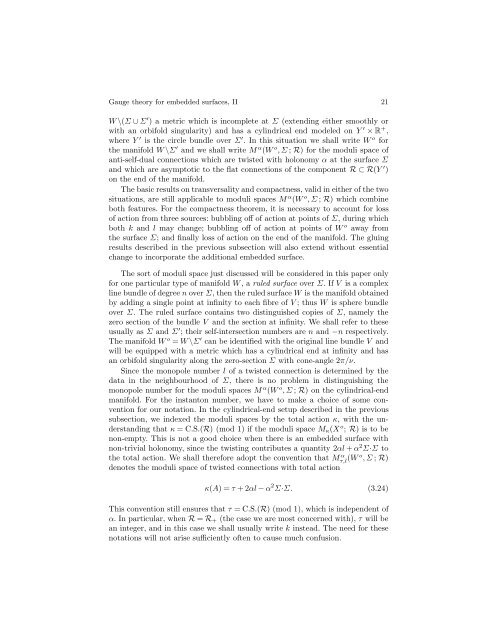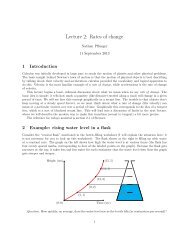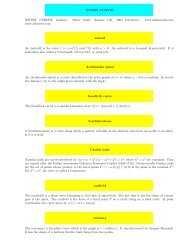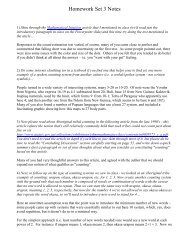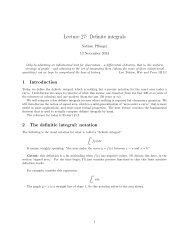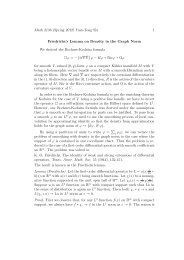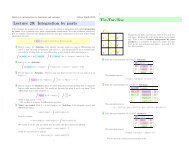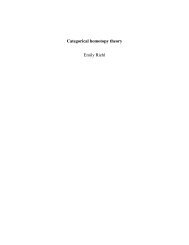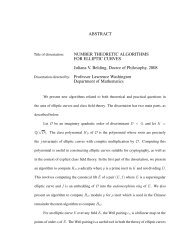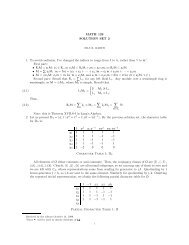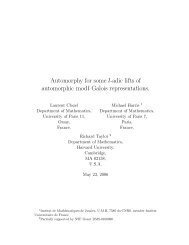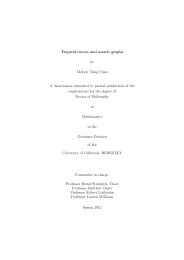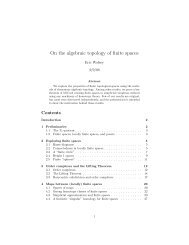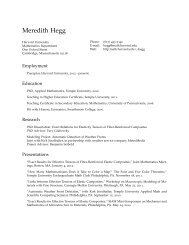Gauge theory for embedded surfaces, II
Gauge theory for embedded surfaces, II
Gauge theory for embedded surfaces, II
You also want an ePaper? Increase the reach of your titles
YUMPU automatically turns print PDFs into web optimized ePapers that Google loves.
<strong>Gauge</strong> <strong>theory</strong> <strong>for</strong> <strong>embedded</strong> <strong>surfaces</strong>, <strong>II</strong> 21<br />
W \(Σ ∪ Σ ′ ) a metric which is incomplete at Σ (extending either smoothly or<br />
with an orbifold singularity) and has a cylindrical end modeled on Y ′ × R + ,<br />
where Y ′ is the circle bundle over Σ ′ . In this situation we shall write W o <strong>for</strong><br />
the manifold W \Σ ′ and we shall write M α (W o ,Σ; R) <strong>for</strong> the moduli space of<br />
anti-self-dual connections which are twisted with holonomy α at the surface Σ<br />
and which are asymptotic to the flat connections of the component R⊂R(Y ′ )<br />
on the end of the manifold.<br />
The basic results on transversality and compactness, valid in either of the two<br />
situations, are still applicable to moduli spaces M α (W o ,Σ; R) which combine<br />
both features. For the compactness theorem, it is necessary to account <strong>for</strong> loss<br />
of action from three sources: bubbling off of action at points of Σ, during which<br />
both k and l may change; bubbling off of action at points of W o away from<br />
the surface Σ; and finally loss of action on the end of the manifold. The gluing<br />
results described in the previous subsection will also extend without essential<br />
change to incorporate the additional <strong>embedded</strong> surface.<br />
The sort of moduli space just discussed will be considered in this paper only<br />
<strong>for</strong> one particular type of manifold W ,aruled surface over Σ. IfV is a complex<br />
line bundle of degree n over Σ, then the ruled surface W is the manifold obtained<br />
by adding a single point at infinity to each fibre of V ;thusW is sphere bundle<br />
over Σ. The ruled surface contains two distinguished copies of Σ, namelythe<br />
zero section of the bundle V and the section at infinity. We shall refer to these<br />
usually as Σ and Σ ′ ; their self-intersection numbers are n and −n respectively.<br />
The manifold W o = W \Σ ′ can be identified with the original line bundle V and<br />
will be equipped with a metric which has a cylindrical end at infinity and has<br />
an orbifold singularity along the zero-section Σ with cone-angle 2π/ν.<br />
Since the monopole number l of a twisted connection is determined by the<br />
data in the neighbourhood of Σ, there is no problem in distinguishing the<br />
monopole number <strong>for</strong> the moduli spaces M α (W o ,Σ; R) on the cylindrical-end<br />
manifold. For the instanton number, we have to make a choice of some convention<br />
<strong>for</strong> our notation. In the cylindrical-end setup described in the previous<br />
subsection, we indexed the moduli spaces by the total action κ, with the understanding<br />
that κ =C.S.(R) (mod 1) if the moduli space Mκ(X o ; R) istobe<br />
non-empty. This is not a good choice when there is an <strong>embedded</strong> surface with<br />
non-trivial holonomy, since the twisting contributes a quantity 2αl + α 2 Σ·Σ to<br />
the total action. We shall there<strong>for</strong>e adopt the convention that M α τ,l (Wo ,Σ; R)<br />
denotes the moduli space of twisted connections with total action<br />
κ(A)=τ+2αl − α 2 Σ·Σ. (3.24)<br />
This convention still ensures that τ =C.S.(R) (mod 1), which is independent of<br />
α. In particular, when R = R+ (the case we are most concerned with), τ will be<br />
an integer, and in this case we shall usually write k instead. The need <strong>for</strong> these<br />
notations will not arise sufficiently often to cause much confusion.


